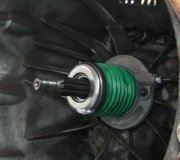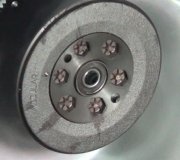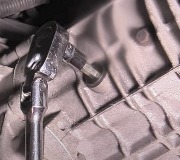This is a classic low fluid condition, here is a generic guide to help you step by step with instructions in the diagrams below to show you how on your car.
https://www.2carpros.com/articles/how-to-check-and-add-transmission-fluid
P0700: This code is a generic transmission control system malfunction code.
P0733: This code specifically indicates that there is an issue with the gear ratio in third gear.
P0843: This code indicates a problem with the transmission fluid pressure sensor/switch A circuit.
Transmission Fluid Checking Procedure - Allison Automatic Transmission
Cold Fluid Check
The purpose of the cold check is to determine if the transmission has enough fluid to be operated safely until a hot check can be made.
1. Important:
The fluid level rises as fluid temperature increases. DO NOT fill above the COLD CHECK band if the transmission fluid is below normal operating temperatures.
Bring the vehicle to a complete stop on a level surface using the service brakes.
2. Ensure that the engine is at low idle RPM (500-800 RPM).
3. With the service brakes applied, put the transmission in the P, PARK, position.
4. Engage the park pawl by slowly releasing the service brakes. The vehicle may move slightly as the pawl engages.
5. Apply the parking brake and ensure it is properly engaged.
6. Run the engine for at least one minute. Apply the service brakes and shift to D, DRIVE, then to N, NEUTRAL, and then shift to R, REVERSE, in order to fill the hydraulic system.
7. Ensure that the engine is at low idle RPM (500-800 RPM).
8. With the service brakes applied, put the transmission in the P, PARK, position.
9. Engage the park pawl by slowly releasing the service brakes. The vehicle may move slightly as the pawl engages.
10. With the engine running, remove the fluid level indicator from the fill tube and wipe the indicator clean.
11. Important:
If the fluid level is within the COLD CHECK band, the transmission may be operated until the fluid is hot enough to perform a HOT RUN check. If the fluid level is not within the COLD CHECK band, add or drain as necessary to bring it to the middle of the COLD CHECK band.
Always check the fluid level at least twice using the procedure described above. Consistent readings are important in order to maintaining proper fluid level. If inconsistent readings persist, inspect the transmission vent assembly to be sure that it is clean and unclogged. If readings are still inconsistent, contact your nearest Allison distribution or dealer.
Insert the fluid level indicator into the fill tube and remove. Check the fluid level reading. Repeat the check procedure to verify the reading.
12. Perform a hot check at the first opportunity after the normal operating sump temperature of 71-93°C (160-200°F) is reached.
Hot Fluid Check
1. Important:
The fluid must be hot to ensure an accurate check. The fluid level rises as temperature increases.
Operate the transmission in D, DRIVE, range until normal operating temperature is reached. Normal operating temperature is any of the following:
Sump temperature 71-93°C (160-200°F)
Converter-out temperature 82-104°C (180-220°F)
If a transmission temperature gage is not present, check the fluid level when the engine water temperature gage has stabilized and the transmission has been operated under load for at least one hour.
2. Bring the vehicle to a complete stop on a level surface using the service brake.
3. Ensure that the engine is at low idle RPM, 500-800 RPM.
4. With the service brakes applied, place the transmission in the P, PARK, position.
5. Engage the park pawl by slowly releasing the service brakes. The vehicle may move slightly as the pawl engages.
6. Apply the parking brake and ensure it is properly engaged.
7. With the engine running, remove the fluid level indicator from the fill tube and wipe the indicator clean.
8. Important:
Always check the fluid level at least twice using the procedure described above. Consistent readings are important to maintaining proper fluid level. If inconsistent readings persist, inspect the transmission vent assembly to be sure it is clean and unclogged. If readings are still inconsistent, contact your nearest Allison distribution or dealer.
Insert the fluid level indicator into fill the tube and remove. Check fluid level reading. Repeat the check procedure to verify the reading.
9. Important:
Safe operating level is within the HOT RUN band on the fluid level indicator. The width of the HOT RUN band represents approximately 1.0 liter (1.06 quarts) of fluid at normal operating sump temperature.
If the fluid level is not within the HOT RUN band, add or drain as necessary to bring the fluid level to within the HOT RUN band.
Fluid Inspection
1. Important:
Transmission fluid must be changed whenever there is evidence of dirt or a high temperature condition. High temperature causes the transmission fluid to be discolored or to have a strong odor. Local conditions, severity of operation, or duty cycle may require more or less frequent fluid or filter change intervals.
Examine the drained fluid for evidence of dirt.
2. Important:
Cooler water may be contaminated by engine oil if an engine oil cooler is present; be sure to locate the correct source of cooler water contamination.
Examine the drained fluid for evidence of water. Obvious water contamination of the transmission fluid or transmission fluid in the cooling water from the heat exchanger indicates a leak between the water and fluid areas of the cooler. Inspect and pressure test the cooler to confirm the leak. Replace leaking coolers.
3. Notice:
Engine coolant in the transmission hydraulic system requires immediate action. Failure to clean or replace all contaminated components may result in premature transmission failure.
Examine the drained fluid for evidence of engine coolant.
4. Examine the drained fluid for evidence of metal. Metal particles in the fluid, other than minute particles normally trapped in the oil filter, indicate internal transmission damage. When this occurs, inspect the inside of the oil pan for excessive metal particles.
5. Metal contamination requires complete transmission disassembly.
6. Notice:
Flush the transmission cooling system and inspect for restrictions following a transmission failure. Failure to repair or replace restricted oil cooling system components may result in premature transmission failure.
Clean all internal and external hydraulic circuits, cooler, and all other areas where the particles could lodge.
Let us know what you find.
Tuesday, March 3rd, 2015 AT 7:29 AM


